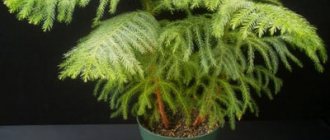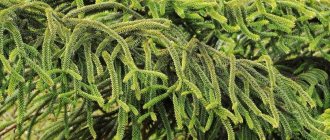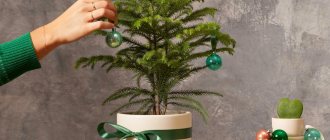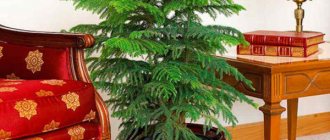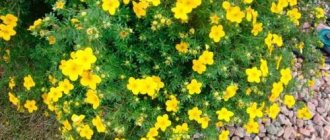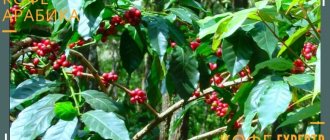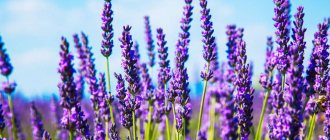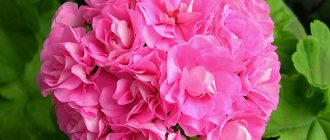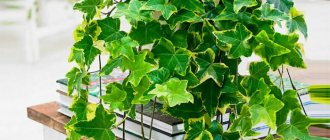Author: Elena N. https://floristics.info/ru/index.php?option=com_contact&view=contact&id=19 Category: Houseplants Published: January 30, 2012Republished: February 27, 2019Last edits: March 12, 2021
- Cook's Araucaria / Araucaria columnaris
Botanical description
About 14 species of plants of the genus Araucaria (lat. Araucaria) belong to the Araucariaceae family. The genus is native to South America and Australia. Representatives of the genus are coniferous plants with hard, needle-shaped leaves. Araucaria seeds can be eaten, and the wood is widely used in furniture making. In the Caucasus, along the Black Sea coast, some species are grown as ornamental. Growing araucaria in dry room air will lead to difficulties - this plant is more suitable for growing in greenhouses. If you do not follow the rules of care, the plant may get sick or even die. Not many coniferous plants can be grown at home - araucaria is one of them. Araucaria is an ornamental deciduous plant (since it is almost impossible to achieve flowering when grown indoors), which is grown in pots or in compositions in winter gardens. They say that the Araucaria plant purifies the air, like its other coniferous relatives.
Mr. Summer Resident informs: Araucaria - benefit or harm
The plant has powerful energy. It can awaken creativity and provoke people to be active. Moreover, the effect is both positive and negative. Araucaria enhances the energy in the house, no matter what it is. There is a sign that a plant in the house activates protective properties, gives peace and tranquility to those living in it.
The beneficial property of spruce is that it moisturizes and purifies the air. People with hypertension should not keep it in the house. And for those who have low blood pressure, on the contrary, it is necessary, but it cannot be placed in the rest room.
Briefly about cultivation
- Flowering: grown as an ornamental foliage plant and rarely blooms at home.
- Lighting: bright light, but with shading from direct sunlight.
- Temperature: in summer – no higher than 20 ºC, in winter – no lower than 10 and no higher than 15 ºC.
- Watering: plentiful in summer, in winter - as the earthen ball dries to 2/3 of its depth.
- Humidity: high. Regular spraying is recommended.
- Feeding: during the period of active growth, twice a month with complex fertilizer with a low calcium content.
- Dormant period: from late autumn to spring.
- Transplantation: in spring or early summer: young araucarias - as they fill the pot with roots, adults - no more than once every 3-4 years.
- Substrate: two parts each of turf soil and sand and one part each of leaf soil and peat.
- Reproduction: seeds and cuttings.
- Pests: aphids and mealybugs.
- Diseases: all diseases of araucaria are caused by poor care and improper maintenance.
Read more about growing araucaria below.
Temperature
The required temperature for araucaria is +10–12 °C. The plant does not tolerate even a slight increase (up to +16 °C): the needles begin to turn yellow.
Chilean Araucaria is not too demanding on the composition of the soil. As a rule, a regular mixture for indoor plants is prepared for it. You can add a peat-containing substrate with an acidic reaction to it. It can be purchased at a specialty store as soil for rhododendrons.
In rooms where the temperature exceeds the recommended one, the plant should be sprayed three times a day. In cool rooms, this procedure should be carried out no more than once every two days. The soil in the pot must be covered with sphagnum moss, which must be moistened regularly.
In summer, watering should be plentiful. The soil should not be allowed to dry out. At the same time, excessive waterlogging can also harm the plant: excess moisture around the roots can lead to yellowing and falling of the needles. Watering is carried out only after the top layer of soil has dried.
In winter, watering is reduced to a minimum, however, even at this time, drying out of the earthen coma is unacceptable. In addition, you should not use hard water for irrigation. Well-settled, rain or boiled water is recommended.
In indoor conditions, Chilean araucaria lives up to ten years if the conditions of maintenance are observed. Yellowed needles indicate that the air in the room is too dry. Consider reliable support for the plant. Fertilizers for azaleas are suitable for feeding. They are used from April to August at intervals of three weeks. Araucaria does not need organic fertilizers.
After acquiring a young plant, you should carefully remove it from the pot, being careful not to damage the earthen ball. If the roots entwine it too tightly, then after 7-10 days it is necessary to transfer the tree (without changing the soil) into a larger pot and add a substrate for coniferous plants. The next transplant will be required only after 3-4 years, when the roots are again tightly entwined with the lump.
This plant is quite resistant to pests, however, sometimes it is affected by mealybugs and pests characteristic of coniferous plants. If you notice white accumulations on the tree that resemble pieces of cotton wool, remove them using a semi-rigid brush, after moistening it with alcohol. After this, treat the plant with Aktara.
Araucaria Chilean is a very spectacular plant that looks great in any interior. As you can see, it does not require complex care when kept indoors (except for strict adherence to temperature conditions).
Caring for araucaria at home
Lighting
Despite the fact that indoor araucaria prefers bright lighting at home, it is advisable to hide the plant from direct sunlight. In summer, it can be taken out into the fresh air in a place protected from rain and sun. The optimal placement option is for the light to fall on the plant from both sides at once. If the light comes from only one side, to ensure even growth it is necessary to rotate the araucaria by 90 ° C weekly.
Temperature
Homemade araucaria needs to be kept cool. The optimal temperature in summer is about 20 °C. In winter, the temperature should be around 10°C, but should not rise above 15°C.
Watering Araucaria
Water the araucaria with settled water throughout the year. In summer, you should not let the earthen ball dry out (it can cause trouble), so watering should be plentiful, but you need to make sure that excess water does not linger in the pot. In winter, water less, especially if the plant is kept at low temperatures.
- Syngonium - care, photos, types
Spraying
It is advisable to spray indoor araucaria with water at room temperature (the water must first sit for at least a day). Spray both in summer and winter, especially if the plant overwinters in a room with central heating.
Top dressing
In spring and summer, the Araucaria tree is fed twice a month with a very weak solution of fertilizers with a low level of calcium. It would be a good idea to fertilize the plant with mullein infusion every four weeks.
Transplanting araucaria
If the roots completely fill the pot, the plant should be replanted. This is done in early to mid-spring or summer. Household araucaria does not tolerate replanting very well, so it is worth replanting those plants that have grown well. Adult specimens are transplanted every three to four years into a wide pot with a mixture of 2 parts sand and turf soil and one part peat and leaf soil. Another option is that the substrate is made up of equal parts of humus, sand, peat, deciduous, coniferous and turf soil. There must be good drainage at the bottom of the pot, which will not allow excess water to stagnate in the pot. This plant grows very well hydroponically.
Growing from seeds
Araucaria seeds cannot be stored for a long time, so they are sown immediately after being collected. They are planted in individual pots. Two substrates are suitable: a mixture of equal parts of sand, leaf, turf and peat soil; Another option is sand and peat with a small amount of fine charcoal. The soil is watered a little and covered with a thin layer of sphagnum. The pot needs to be ventilated and sprayed from time to time, and the temperature should be around 20 °C. Seeds germinate in different ways - some after 2 weeks, others after 2 months. When the roots of a young araucaria completely fill the pot, it is transplanted into a larger pot.
Propagation of araucaria by cuttings
For cuttings of araucaria, the upper branches of the plant, which are half woody, are suitable. They are cut a few centimeters below the whorl in early to mid-spring. The cut cuttings should lie in a shady place for 24 hours, after which the resinous juice is cleaned from the cutting site and powdered with finely crushed charcoal. It would not be superfluous to treat the cuts with a root formation stimulator. The cuttings are planted in individual containers with sand or a mixture of equal parts of sand and peat, after which the container with the cuttings is covered with a cut plastic bottle or glass jar. Pots with cuttings are regularly ventilated, sprayed and the temperature is maintained at 25 °C. At this temperature, the cuttings will root in a couple of months, but if the temperature is lower, it may take up to five months for rooting - you need to be patient. When the cuttings take root and the roots completely fill the pot, the young araucaria is transplanted at home into a large pot with soil for an adult araucaria.
Bibliography
- Bailey, L. H. and E. Z. Bailey. 1976. Hortus Third i–xiv, 1–1290. MacMillan, New York.
- Forzza, RC 2010. List of species of Flora do Brasil https://web.archive.org/web/20150906080403/https://floradobrasil.jbrj.gov.br/2010/ . Botanical Garden of Rio de Janeiro, Rio de Janeiro.
- Idarraga-Piedrahita, A., R. D. C. Ortiz, R. Callejas Posada, and M. Merello. (ed.) 2011. Fl. Antioquia: Cat. 2:9–939. University of Antioquia, Medellin.
- Jorgensen, Prime Minister and S. Leon-Yanez. (ed.) 1999. Cat. Vask. pl. Ecuador, monograph. Syst. Bot. Miss Bot. Guard. 75:i–viii, 1–1181. Missouri Botanical Garden, St. Louis.
- Killeen, T.J., E. Garcia Estigarribia, and S.G. Beck. (ed.) 1993. A Guide to Wood. Bolivia 1–958. National Herbarium of Bolivia and Missouri Botanical Garden, ed. Quipus srl., La Paz.
- Linares, J. L. 2003 [2005]. An annotated list of native and cultivated trees in the Republic of El Salvador. Ceiba 44(2):105–268.
- Lopez, Jay and Jel Little. 1987. Common trees of Paraguay 1–425. Peace Corps, Information Collection and Sharing, Washington, DC
- Molina Rosito, A. 1975. Inventory of plants of Honduras. Ceiba 19(1):1–118.
- Nelson, C. H. 2008. Cat. pl. Vask. Honduras 1–1576.
Diseases and pests of araucaria
Araucaria does not grow after pruning. If you damage the upper part of the plant, its further development may be incorrect or stop altogether.
- Jatropha (Jatropha) – care, photos, types
When growing araucaria in an apartment, special attention should be paid to air humidity (should not be dry), lighting (should have a lot of bright diffused light), temperature (should not be too low in winter).
Araucaria dries and crumbles. The needles fall off, and the shoots dry out and turn yellow if the araucaria does not have enough moisture and light.
Araucaria branches droop from excessive watering or at too high a temperature.
Araucaria grows slowly. The plant slows down its development and growth if there is too much calcium in the substrate.
The branches of Araucaria are thin. Young shoots will be thin if the araucaria is not fertilized enough.
Pests of Araucaria. Damage to the plant is caused by both pests of coniferous plants and the familiar mealybugs and aphids.
References
- Farjeon, A. (2006). Araucaria angustifolia. _
IUCN
Red List of Threatened Species 2010.2
. ISSN 2307-8235. Retrieved August 23, 2010 - The name curý
, originating from Guaraní, has many transcriptions in different texts:
cury
,
curí
,
curî
,
cury'i
, etc. - Araucaria angustifolia in the tropics
- In botanical epithets
- Wikimedia Commons has media related to Araucaria angustifolia. List of plants
. Retrieved July 24, 2014. - Wikimedia Commons has media related to Araucaria angustifolia. Royal Botanic Gardens, Kew: World Checklist of Selected Plant Families
. Retrieved July 24, 2014. - "LAW XVI - No. 19 (before Law 2380)". Archived from the original on March 4, 2016. Retrieved February 17, 2022
Kinds
Cook's Araucaria / Araucaria columnaris
Habitat - o. Pine and tropical parts of the southern New Hebrides. The branches from the trunk grow at an angle of almost 90 °C, gather in whorls, and are relatively short. Usually the crown expands towards the top. The cones grow up to 10 cm in length and appear bristly due to the awl-shaped appendage extending downwards. The leaves are soft, the apex tapers very smoothly. This species is usually grown by residents of tropical and subtropical countries.
- How to grow coleus in a flower garden
Araucaria heterophylla (Indoor Spruce) / Araucaria heterophylla
Or Indoor Spruce. They live on Norfolk Island and grow up to 60 m. The bark is brownish in color and flaky. The branches grow perpendicular to the trunk, which gives the crown of the plant a pyramidal shape. The leaves on the branches grow in a spiral, needle-shaped, grow no more than 2 cm in length, tetrahedral and bend slightly upward. Amateur flower growers quite often mistake this species for Araucaria excelsa - tall araucaria.
Araucaria angustifolia
It lives in the mountains of southern Brazil, where it is also known as Brazilian araucaria (Araucaria brasiliana). Under natural conditions, these trees grow up to 50 m, and in rooms - up to 3 m. Bright green five-centimeter linear-lanceolate leaves grow on thin hanging branches. Wood of this type is used in the construction and furniture industries, in the production of paper and musical instruments.
Chilean Araucaria / Araucaria araucana
This plant can be found in natural conditions in Chile and western Argentina. The trunk grows up to 60 m in height and only 1.5 m in diameter. The bark of this species is thick, covered with longitudinal cracks, and resinous. The lower branches usually lie on the ground and fall off as they age. Side branches grow in whorls of 6-7 pieces; in middle-aged trees they grow perpendicular to the trunk, and in old trees they hang down slightly. The leaves are dark green in color, grow on the branches in a spiral and are very dense, prickly and hard. The seeds are not only edible, but tasty and healthy. Wood is used in construction.
taxonomy
Araucaria angustifolia
was described by (Bertol.) Kuntze and published in
Revisio Generum Plantarum
3(3): 375. 1898. [3]
Etymology
of Araucaria
: a general geographical name alluding to its location in Arauco.
angustifolia
: Latin epithet meaning "with narrow leaves."
[ 4 ] Synonyms
- Araucaria brasiliensis
A.Rich. - Araucaria brasiliensis var.
gracilis Career - Araucaria brasiliensis var.
ridolfiana (P.Savi) Gordon - Araucaria brasiliensis var.
saviana (Parl.) Parl. - Araucaria brasiliensis
Loudon - Araucaria brasiliensis
A. Rich. - Araucaria brasiliensis var.
saviana (Parl.) Parl. - Araucaria dioecious
(Vell.) Stellfeld - Araucaria elegant
Quarry - Araucaria ridolfiana
Pi.Savi - Araucaria saviana
Parl. - Columbia angustifolia
Bertol. - Columbea brasiliana
(A.Rich.) Career - Columbea brasiliana var.
Elegance Career - Columbea brasiliana var.
ridolfiana (Pi.Savi) Career - Columbea brasiliensis var.
Ridolfina (P. Savi) Career - Pine dioecious
Well. [ 5 ] [ ]
Reproduction
Araucaria can be propagated using cuttings and seeds. Growing from seed material is distinguished by its duration and labor intensity:
- For sowing, you need to use only fresh seeds; perennial seeds are not suitable;
- Prepare a container and sow seeds in it, moisten it well and cover with moss;
- Place the containers in a warm place where the temperature will not fall below 20 degrees Celsius;
- Be patient, seedlings will not appear quickly, planting requires careful care;
- Do not expose the sprouts to direct sunlight, they will very quickly become yellow, dry and eventually die;
- After the young shoots get stronger and grow a little, the entire planting needs to be thinned out and about 10 cm of free space left between the plants.
Grown plants are seated in separate containers and then grown in accordance with all the rules.
More details about the tree in the video:
The cutting method is used in the summer season:
- Shoots that have already become woody are suitable for rooting. It is better to use branches from the top of the plant; if you cannot get them, use side shoots;
- Choose a suitable branch and cut half of it. Dry the prepared cutting in the sun and treat it with crushed coal;
- A mixture of sand and peat is suitable as a soil. Moisten the soil and place the cutting in it for subsequent rooting. The planting must be covered with a plastic jar;
- Water periodically and use a spray bottle to moisten;
- The temperature must be at least 25 degrees Celsius, otherwise rooting will take place much more slowly;
- By the winter, rooting will be successful and the plants can be planted for permanent residence.
Scientific name
The Latin name for Chilean Araucaria is “ Araucaria araucana ”. In common parlance, the plant is called Chilean needles. The name comes from the Mapuche Indian people living in the Araucano region.
The Indians called the tree "Pehuen". Pine was a sacred plant. Therefore, the people called themselves “Pehuenches” - “sacred people”.
Araucaria Chilean: photo of an unusual needle for us.
external links
- Gymnosperm Database: Araucaria angustifolia
| authoritative control |
|
- Data: Q899179
- Multimedia: Araucaria angustifolia.
- Species: Araucaria angustifolia.
Transplanting a plant
Indoor araucaria does not tolerate transplantation very well - after it it can get sick and even die. Therefore, it is often not worth disturbing the plant, and if it is necessary to transfer it to another pot, many conditions must be observed:
- the maximum frequency of transplanting adult Christmas trees is once every three to four years,
- manipulations can only be performed from March to mid-May,
- when replanting, the old earthen ball is preserved as much as possible - it is better to transfer absolutely all the soil from the old one to a new pot,
- the root collar cannot be covered with fresh soil - it should be approximately at the same level as in the previous container,
- large trees over a meter tall are not replanted at all - they simply add fresh soil on top or replace the thin top layer of soil with fresh one.
After transferring to a new pot, Araucaria takes several weeks to adapt. At this time, it requires daily spraying, thorough watering and no direct sunlight. It is better to move the flower to a slightly shaded room until it is fully adapted, and then return it to its usual place.
Araucaria araucana
Family "Araucariaceae" - Araucariaceae
Araucaria Chilean (or Arauca) is a coniferous tree, its homeland is Chile. Although, Araucaria Chilean grows not only in Chile, but also in the western part of Argentina. Now it is widespread in Western Europe, and in the territory of the former USSR - only in the botanical gardens of the Crimea and the Caucasus. Araucaria Chilean forms pure or mixed forests with southern beech (Nothofagus). Araucaria forests develop best on volcanic soils. The densest thickets of araikaria are found on the slopes of volcanoes. These are very large trees, reaching a height of 60 m with a trunk diameter of up to 1.5 m. The crown of young trees is wide-pyramidal. With age, the lower branches fall off. Its bark is resinous, thick, and longitudinally fissured. The leaves of Araucaria Chilean are hard and prickly, dark green, spirally arranged, covering the branches tightly to each other. Let me emphasize that Chilean araucaria has very hard and prickly leaves. The leaves are 2.5-4 cm long, 1.5-2.5 cm wide, ovoid in shape with a pointed tip, attached to the shoot with a wide base. Leaves live up to 40 years. Cones on short lateral branches, the vegetative leaves of which gradually turn into cone scales. Mature cones are brown, spherical, 12-18 cm in diameter, reach a weight of 1.6 kg, initially covered with long, elongated up to 3 cm and curved upward tips of covering scales, which subsequently break off. Mature trees produce 20-30 cones, each of which contains up to 200-300 large seeds. When ripe, the cone crumbles. The mature seed is oblong, slightly compressed, 2.5-4 cm long; narrow edges and the remains of a wing are visible along the edges of the seed. Chilean Araucaria is light-loving, grows in humid climates, on evenly moist, but not swampy, soils sufficiently rich in nutrients. It tolerates dry conditions well, as well as light frosts. The large seeds of Chilean araucaria are very nutritious and tasty. The Araucan Indians eat them raw or roasted. The wood of this araucaria is yellowish-white in color and is used in construction. The resin is used in Araucanian folk medicine. Araucaria Chilean is a very valuable ornamental plant. It is propagated by seeds and cuttings. In culture, araucaria, as a rule, does not grow higher than 1.5 meters. Native to the Chilean and Argentine Andes, Chilean Araucaria is sometimes found in southern Germany, Italy and the Mediterranean. It usually decorates gardens in areas with mild climates. It takes a lot of effort to grow a young araucaria tree: this is not easy to do indoors, since the plant needs good lighting and a cool location in winter. Thanks to winter gardens that have come back into fashion, araucaria has begun to be grown in urban areas.
How does it reproduce?
Araucaria is mainly propagated by cuttings, but you can try to grow a Christmas tree from seeds - however, this will take a lot of time and require some patience.
Cuttings
Cuttings, unlike planting seeds, are carried out in July, not in spring:
- for planting, young cuttings are taken from the tops of the crown,
- the cut cuttings are dried for about a day, then the lower part is cleaned of resin, wiped with ash or fine coal,
- cuttings are planted in a prepared mixture of sand and peat, well moistened, then they are covered with film (you can use a jar),
- seedlings must be watered, sprayed, film removed daily for ventilation and access to oxygen,
- Low temperatures should not be allowed during the rooting period - ideal for future Christmas trees is 25-26 degrees.
At the end of October, the cuttings will acquire an extensive root system and can be transplanted into separate pots.
Seeds
Germination and further survival of the seeds is poor. For planting, it is recommended to take fresh, just collected seeds. Even after storage for two to three weeks, sprouts may not appear, as the seeds will lose their viability:
- the seeds are sown in very moist soil and must be covered with a layer of moss on top, which is constantly moistened,
- the temperature in the room where the pot is located should not fall below 20 degrees and rise above 26,
- as soon as the seedlings hatch, they need to be removed from a sunny place,
- grown bushes are thinned out - leaving a distance of at least 10 cm between shoots, then each sprout is transplanted into a separate pot.
In the future, care for short plants is carried out in the same way as for adults.

